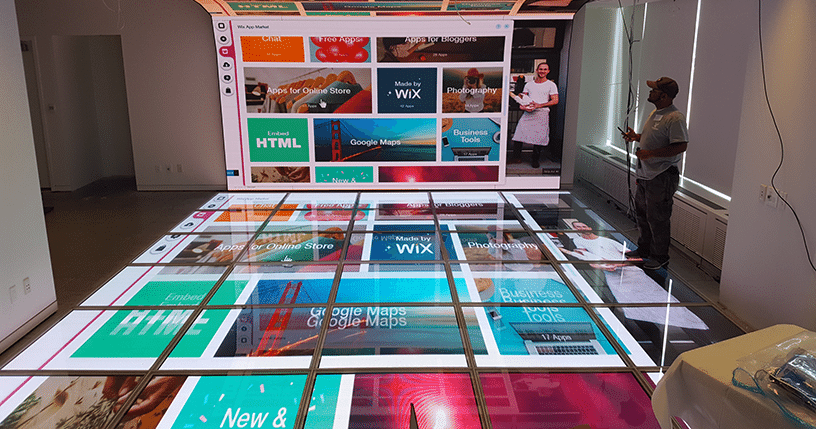Since LED displays came onto the scene in the 1970’s, they’ve captured customers’ attention providing more recall for advertisers and local messaging. Stunning images, seen day or night with bright, bold colors, have paved the way for many innovations in the digital signage industry. We’ve seen displays evolve from thick bezels and heavy screens to thinner, brighter, and ultra-flexible tiles to suit any application.
Direct View LED has become so versatile, thin, and ubiquitous that it can easily be integrated into nearly any project. These displays have become increasingly popular in recent years due to their flexibility and the ability to create large-scale, high-resolution displays with vibrant and dynamic visuals. As technology continues to advance, there are a few emerging trends in Direct View LED displays that are worth taking note of. Here are some interesting trends we’re seeing in the industry…
Smart dvLED Technology
Smart dvLED technology is an amazing advancement as tiles that self-calibrate, and color match neighboring tiles are incredible. With this innovation in dvLED technology, gone are the days of frequent tile replacement and costly maintenance.
Eco-Friendly dvLED
Sustainability is something we will continue to hear more and more on in the future. Many businesses are turning to dvLED solutions due to their energy efficiency and lower environmental impact. dvLED displays are more energy-efficient and require fewer materials to manufacture, making them a great choice for businesses looking to reduce their carbon footprint. If you haven’t read about AVIXA’s Sustainability Initiatives, we suggest you do, as green initiatives will continue to trend. Nanolumens is committed to fostering a sustainable future by aligning our design, production, and supply processes to minimize environmental impact and optimize the well-being of our community. Read about our sustainability efforts here.
Flexible Displays
Flexible displays are an intriguing technological advancement because they may support slim, lightweight, and distinctive form factors. It a recent Nanolumens event in Los Angeles, Todd Alan Green likened flexible dvLED displays to “digital drywall”, where displays can quite literally be placed anywhere to create a dynamic canvas.
Immersive Displays
Many industries use immersive display technologies in different ways. For instance, interactive virtual reality (VR) environments offer improved perception to raise engagement and learning in virtual meeting spaces.
Startups and scaleups in the display technology industry also create tiny panels and lenses that mimic giant screens. By engulfing the majority of the user’s field of view (FOV), this provides panoramic virtual screens.
In addition, these screens provide users interactive augmented realities (AR) via head-mounted displays (HMDs). As a result, enhanced shopping is made possible and situational awareness enhances decision-making. Immersive screens make it possible for convenient, customized experiences.
Flipchip COB – MiniLED
The industry has been buzzing with miniLED for some time now, however miniLED is just now beginning to reach scale due to various manufacturing hurdles being overcome and cost coming down. If you are unfamiliar, MiniLED is, as you can guess by its name, a mini form of the more traditional SMD LED. Due to its smaller footprint, manufacturers can achieve tighter pitches and drive higher contrast due to the increased black area between pixels.
MiniLED is being offered in a new format called Chip-on-board (COB) as well as Mini-in-Package (MIP) which utilizes the more traditional SMT manufacturing method. The primary advantage of the COB format is that the chip is bonded directly to the board itself removing the traditional wire bonding of the SMD package. This new methodology reduces one of the primary failure points in manufacturing, gaining higher yield, and it also proves to be less susceptible to environmental factors in the field leading to less failures. Nanolumens’ Engage Pro is a great example of this technology.
OLEDs
Organic electroluminescent material is contained on flexible sheets called OLEDs, which emit flat light. They are therefore thinner and do not need a backlight which makes them more effective than LCDs. OLEDs offer better image quality by boosting contrast and brightness. They enable a broader color gamut, higher refresh rates, and fuller viewing angles.
It is one of the most promising substitute display technologies for plasma and LCD panels. Manufacturers of smartphones and accessories employ OLED panels, especially flexible OLEDs, in their creations.
Quantum Dots
Little phosphorescent crystals used in quantum dot or quantum dot LED (QLED) displays react to light and electricity. These tiny nanoparticles are illuminated by blue light as opposed to typical LEDs, which employ pure white backlights. They consequently emit red or green light, enabling more precise and highly saturated colors than a typical LED.
Longer longevity and improved energy efficiency are just two advantages of QDs. They also permit a wider range of panel sizes and have reduced burn-in. Televisions are currently the most prevalent displays that make use of this technology. On the other hand, scaleups and startups are utilizing quantum dots to improve gaming through high-performance monitors.
Transparency
Transparent displays are an exciting emerging trend in direct-view LED displays. By making the LEDs more transparent, manufacturers can create displays that allow light to pass through them, resulting in an almost see-through effect. This technology opens a whole new range of possibilities, allowing for displays to be placed in front of windows, or even in front of other objects, without blocking them out completely. Nanolumens’ CLRVision and CLRVU are both in range of transparency from 32% – 65%.
It’s exciting to be on the cutting-edge of direct-view LED displays as they rapidly evolve. Stay tuned for more advancements in LED technology from us!

